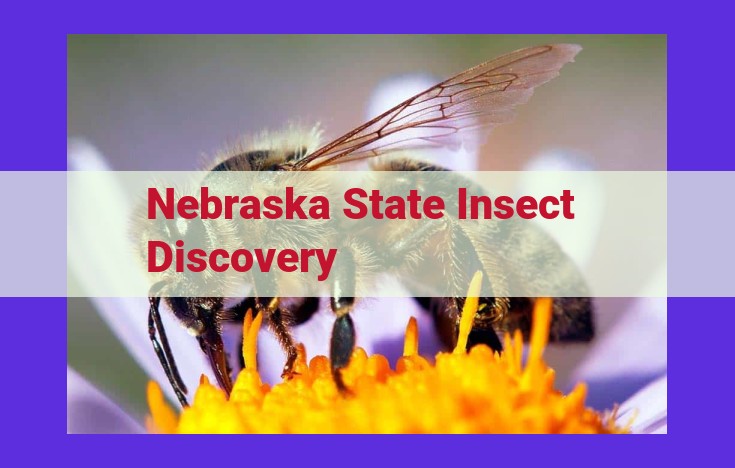Nebraska’s State Butterfly: Exploring Symbolism, Conservation, And Educational Significance
Nebraska’s Mourning Cloak butterfly (Vanessa atalanta), designated as the state insect in 2005, holds significant symbolism, representing resilience and adaptation. Its selection involved Nebraska schoolchildren, fostering an appreciation for biodiversity. The discovery inspired conservation efforts and educational initiatives, connecting Nebraskans to their natural heritage. The Mourning Cloak butterfly stands as a testament to the rich biodiversity of Nebraska, highlighting the importance of preserving and celebrating the state’s unique natural treasures.
Every state holds a special connection to its natural heritage, and Nebraska is no exception. In 2005, the Mourning Cloak Butterfly was proudly designated as the state insect, a testament to the state’s commitment to biodiversity and the unique ecological significance of this captivating creature.
The selection of a state insect isn’t merely a symbolic gesture; it reflects the values and aspirations of a community. For Nebraska, the Mourning Cloak Butterfly embodies resilience, adaptation, and the importance of preserving the state’s natural wonders. Its journey to becoming the state insect is an inspiring tale that highlights the power of community involvement and the transformative impact of connecting with the natural world.
The Mourning Cloak Butterfly: A Closer Look
The Mourning Cloak Butterfly (Vanessa atalanta), chosen as Nebraska’s state insect in 2005, is a mesmerizing creature that embodies resilience and adaptability. Its scientific name reflects its migratory nature, with “Vanessa” honoring the Greek goddess of butterflies and “atalanta” meaning “wanderer.”
Physical Characteristics and Habitat
This eye-catching butterfly boasts a wingspan of up to 3 inches. Its forewings are a deep, velvety black adorned with a row of blue spots, while the hindwings are a rich, mottled brown with a yellowish-orange band along the outer edge. The Mourning Cloak Butterfly prefers forested areas, especially those with moist, sunny spots. It can also be found in meadows, along streams, and even in urban gardens.
Unique Features and Behavior
One of the most fascinating features of the Mourning Cloak Butterfly is its ability to survive the winter. Unlike most butterflies that perish with the cold, this species hibernates as an adult. During hibernation, it seeks sheltered spots, such as under loose bark or in crevices, and remains dormant until warmer temperatures return.
The Mourning Cloak Butterfly is also known for its erratic flight pattern, which helps it avoid predators. Its fluttering, gliding movements make it difficult to predict its trajectory, providing an advantage in escaping danger.
Symbolism and Significance
The Mourning Cloak Butterfly’s resilience and adaptability made it an apt choice as Nebraska’s state insect. Its ability to endure the harsh winters and emerge anew in the spring symbolizes the strength and perseverance of the state’s people. Additionally, its yellowish-orange band represents the golden plains of Nebraska, while its blue spots evoke the clear skies that grace the region.
The Discovery Process: Involving Nebraska’s Youth
The selection of Nebraska’s state insect was a captivating process that engaged the entire community, particularly the state’s young minds. In 2004, a bill was introduced in the Nebraska legislature to establish the state insect. The bill outlined the process, which included a public vote to select the insect.
Nebraska schoolchildren played an integral role in the discovery process. They were encouraged to submit insect nominations and conduct research on the various candidates. The Nebraska Statewide Arboretum also hosted educational programs to teach children about the importance of insects and their role in the ecosystem.
The public voting process was a resounding success, with over 20,000 votes cast. The Mourning Cloak Butterfly emerged victorious, capturing the hearts of Nebraskans. On April 4, 2005, Governor Dave Heineman officially designated the Mourning Cloak Butterfly as the state insect of Nebraska.
The designation of the Mourning Cloak Butterfly was a testament to the power of collaboration and the passion of Nebraska’s youth. The process not only resulted in the selection of a beautiful and symbolic insect to represent the state but also fostered a deeper appreciation for the natural world among future generations.
Beyond the Discovery: Impacts and Values
- Explain the positive impact the discovery had on conservation efforts.
- Discuss the educational value of the state insect program.
- Explore how the discovery connected Nebraska residents to their natural heritage.
Beyond the Discovery: Impacts and Values of Nebraska’s State Insect
The discovery of Nebraska’s state insect, the Mourning Cloak Butterfly, extended beyond the initial designation. Its significance reverberated across the state, fostering conservation efforts, igniting educational initiatives, and forging a profound connection between Nebraskans and their natural heritage.
Environmental Conservation
The Mourning Cloak Butterfly’s status as Nebraska’s state insect has catalyzed conservation efforts. Its habitats, such as woodland edges and wet meadows, have received increased attention, leading to the protection of these vital ecosystems. Furthermore, the butterfly’s reliance on native plant species has raised awareness of the importance of preserving Nebraska’s biodiversity.
Educational Value
The state insect program has proven to be an invaluable educational tool for Nebraska’s youth. Since 2005, schoolchildren have been actively involved in studying and observing the Mourning Cloak Butterfly. This engagement has fostered an appreciation for entomology and ecology, fostering a generation of future scientists and environmentalists.
Connecting Nebraskans to their Natural Heritage
The Mourning Cloak Butterfly has become an emblem of Nebraska’s rich natural heritage. Its familiar pattern and vibrant colors have endeared it to Nebraskans of all ages. By selecting the Mourning Cloak as their state insect, Nebraskans have celebrated their connection to the land and its diverse wildlife, fostering a sense of pride and stewardship.
